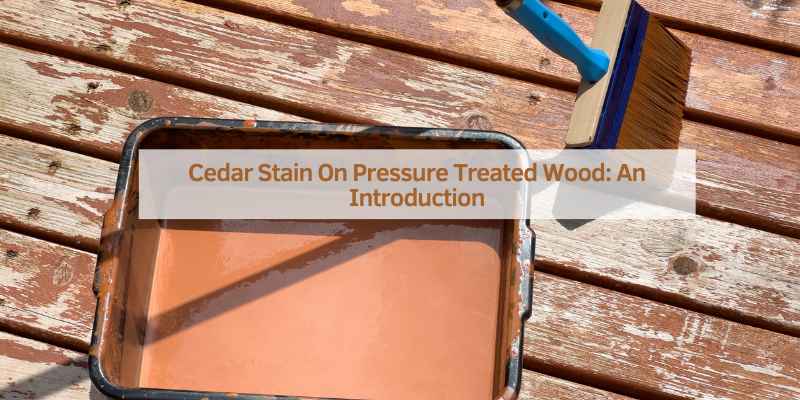Cedar stain on pressure-treated wood enhances its appearance and provides protection against the elements. Proper preparation is crucial for optimal results.
Pressure-treated wood is often used for outdoor projects due to its resistance to decay and insect damage. Applying a cedar stain can further enhance its aesthetic appeal while offering additional protection. Before staining, ensure the wood is clean and dry to allow for proper stain absorption.
Choose a high-quality cedar stain designed for pressure-treated wood to achieve the best results. Regular maintenance will help preserve the wood’s beauty and longevity. This approach ensures your outdoor structures remain attractive and durable, blending the natural charm of cedar with the robustness of pressure-treated wood.
Cedar Stain On Pressure Treated Wood: An Introduction
Cedar stain enhances the look of wood. It brings out the natural beauty. It also protects the wood from damage. Stains can prevent water from seeping into the wood. This reduces the risk of rot. Stains add a layer of protection against UV rays. This helps in keeping the wood from fading. Cedar stain can extend the life of your wood. It makes the wood last longer.
Pressure treated wood is made to resist decay. It undergoes a special process. Chemicals are infused into the wood. This makes the wood last longer. Such wood is ideal for outdoor use. It can withstand harsh weather. However, it can look plain and dull. Adding a cedar stain can improve its appearance. The stain adds color and charm. It also adds an extra layer of protection. This makes the wood even more durable.

Preparation For Staining
Clean the wood surface to remove dirt and debris. Use a stiff brush and soapy water. Rinse the wood well with clean water. Let the wood dry completely. This can take up to 48 hours. A clean surface helps the stain to adhere better.
Sanding the wood makes it smooth and ready for staining. Use fine-grit sandpaper for best results. Sand in the direction of the wood grain. This prevents scratches. After sanding, remove dust with a damp cloth. A smooth surface ensures an even stain.
Choosing The Right Cedar Stain
There are different types of cedar stains. Each one offers unique features. Oil-based stains are popular. They penetrate deeply into the wood. Water-based stains dry faster. They are easier to clean up. Semi-transparent stains show the wood grain. Solid stains provide more color. They hide the wood grain.
Cedar stains come in many colors. Some are light. Others are dark. Natural cedar color is also an option. Opacity affects the look. Transparent stains have no color. Semi-transparent stains add a hint of color. Semi-solid stains cover more. Solid stains offer the most color. They look like paint.
Application Techniques
Brushes give you more control. You can apply an even coat. Brushes are great for small areas. They are also good for detailed work. Sprayers cover large areas quickly. They save time. Sprayers may waste some stain though. They can also be messy. Both methods have their benefits. Choose based on your project’s needs.
First, let the wood dry after the first coat. This usually takes a few hours. Apply the second coat the same way. Make sure to cover all areas evenly. Multiple coats give a richer color. They also add extra protection. Use as many coats as needed. Stop when you reach the desired look.
Weather And Timing Considerations
The best season for staining is spring or fall. Spring and fall have moderate temperatures. Avoid summer and winter for staining. High heat in summer dries stain too fast. Cold in winter prevents proper stain absorption. Spring and fall provide ideal conditions. Cool and dry weather helps the stain to set well.
Check the weather forecast before staining. Rain can ruin fresh stain. Plan for a dry period of at least 48 hours. Humidity can also affect stain drying. Choose a week with low humidity. Wind can blow dust onto wet stain. Avoid windy days for staining. Monitor the weather closely for best results.
Maintenance Tips
Clean your wood often to keep it looking good. Use a gentle soap and water mix. Scrub the wood with a soft brush. Rinse well with clean water. Let the wood dry before you stain it again. Regular cleaning helps the stain last longer.
Stain your wood again every one to two years. Check the wood for any signs of wear. Reapply the stain if the color looks dull. Fresh stain protects the wood better. Follow the stain maker’s instructions for the best results.
Common Mistakes To Avoid
Staining too soon can cause problems. The wood needs time to dry. Wet wood won’t absorb the stain well. It can lead to uneven color. Wait at least six months. This gives the wood time to dry out. Check the moisture level first. Use a moisture meter. The level should be below 15%. This ensures the wood is dry enough.
End-grain absorbs more stain than the rest of the wood. This can make it look darker. Seal the end-grain first. Use a clear wood sealer. Apply it before staining the whole piece. This keeps the color even. It also protects the wood from moisture. This step is very important. Don’t skip it.
Environmental And Safety Precautions
Choosing eco-friendly stains helps the environment. These stains have low volatile organic compounds (VOCs). They are safer for kids and pets. Eco-friendly stains are better for your health. They reduce harmful emissions. You can find them at most stores.
Always wear gloves when staining wood. Gloves protect your skin from chemicals. Use safety goggles to shield your eyes. A mask will help you avoid inhaling fumes. Long sleeves and pants protect your skin. Make sure to work in a well-ventilated area.
Comparing Cedar Stain With Other Finishes
Cedar stain soaks into wood. Paint sits on the surface. Stain shows wood grain. Paint hides it. Stain is easier to apply. Paint needs more steps. Stain ages better. Paint can chip and peel. Stain requires less maintenance. Paint needs frequent touch-ups.
Cedar stain adds color. Sealers are clear. Stain enhances natural beauty. Sealers protect without changing the look. Stain penetrates wood fibers. Sealers form a barrier. Both protect from water. Stain gives UV protection. Sealers may not. Stain needs reapplying less often.
Case Studies And Success Stories
Many users have shared their before and after photos. The results are stunning. Pressure treated wood looks dull and lifeless at first. After applying cedar stain, the wood gains a rich, warm color. This transformation can improve the overall appearance of any outdoor space. One user noted that their deck looked brand new after staining.
Another user shared their fence transformation. The fence looked worn out before. After the cedar stain, it looked vibrant and fresh. These stories show how cedar stain can revitalize pressure treated wood. Many homeowners have found great success with this method.
Cedar stain not only enhances beauty but also adds durability. Users have reported that their stained wood lasts many years without fading. One homeowner shared that their deck, stained five years ago, still looks fantastic. The cedar stain helps to protect the wood from weather damage.
Another user mentioned their stained pergola. It has withstood harsh winters and hot summers without losing its charm. These success stories prove that cedar stain on pressure treated wood is a long-term investment. It keeps outdoor structures looking beautiful and strong.

Frequently Asked Questions
Can You Use Cedar Stain On Pressure Treated Wood?
Yes, you can use cedar stain on pressure treated wood. Ensure the wood is dry and clean before staining.
What Stain Is Best For Pressure Treated Wood?
The best stain for pressure treated wood is a semi-transparent, oil-based stain. It penetrates deeply, protecting against moisture and UV damage.
What Happens If You Stain Pressure Treated Wood?
Staining pressure treated wood enhances its appearance and provides extra protection against moisture and UV damage. Ensure the wood is dry before staining for best results.
Should I Sand Pressure Treated Wood Before Staining?
Yes, sand pressure treated wood before staining. Sanding removes surface imperfections and opens the wood pores, ensuring better stain absorption.
Conclusion
Choosing the right cedar stain for pressure treated wood enhances its beauty and durability. Proper preparation is key. Follow our tips for a stunning finish. Enjoy a long-lasting, attractive wooden surface. With the right approach, your wood projects will stand out and endure.
Happy staining!


